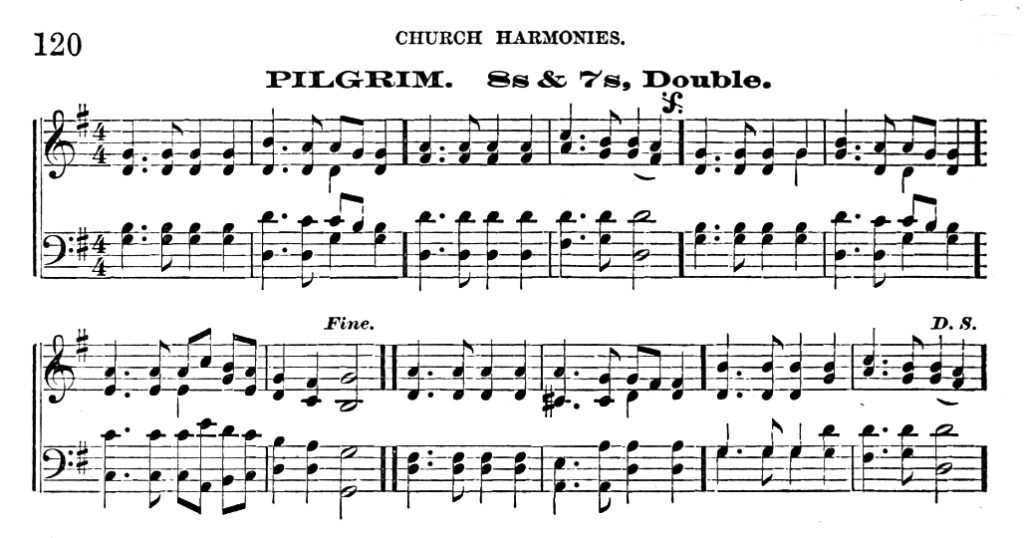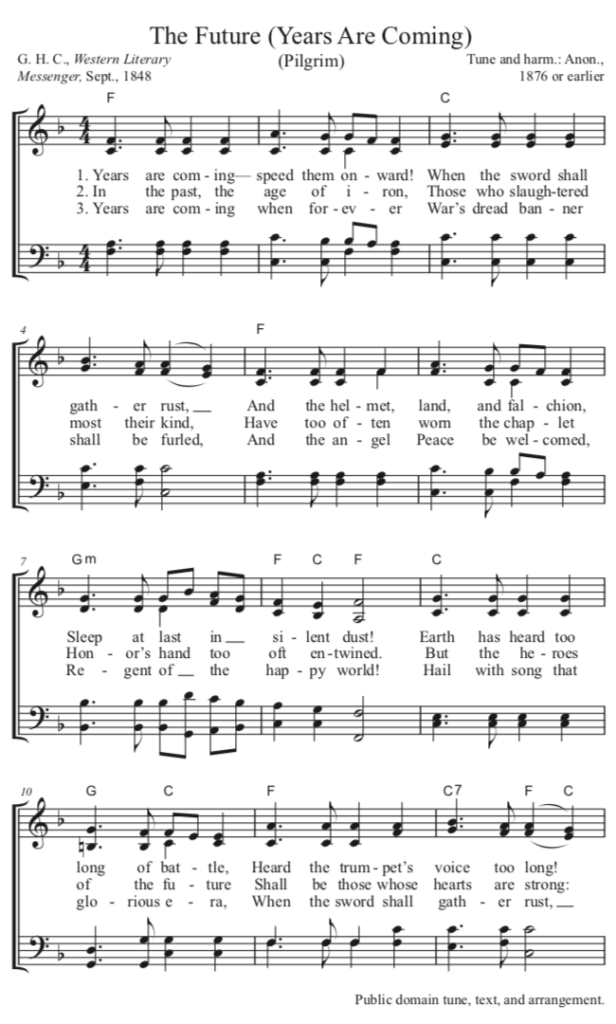One of my favorite hymns about peace begins:
Years are coming — speed them onward!
When the sword shall gather rust,
And the helmet, lance, and falchion,
Sleep at last in silent dust!
This hymn has mostly been reprinted in Universalist and Unitarian Universalist hymnals, and it is usually attributed to the Universalist minister Adin Ballou, who founded the utopian Hopedale community in Milford, Massachusetts, in 1842. Ballou and the members of the Hopedale community were believers in women’s rights and abolition and temperance and education and pacifism. Recently, while I was researching family history, I discovered that my mother’s great-grandparents Nathan Chapman and Hepzibah Whipple left the utopian Rogerenes of Ledyard, Conn., to join the nearby utopian Hopedale community in Massachusetts; and their daughter Jeannette was married in Hopedale to her husband Richard Congdon by none other than Rev. Adin Ballou; and though by the time of this marriage the Hopedale community had gone bankrupt, the spirit of the community lived on in the Hopedale Unitarian church of which Ballou was the minister.
Not only did this family history help explain why I’m a feminist, pacifist, educator, and utopian dreamer, but I decided it must explain why I like this hymn so much.
Except that Adin Ballou didn’t write this hymn.
The poem that begins “Years are coming” did, in fact, first appear as a hymn in Adin Ballou’s Hopedale Collection of Hymns and Songs for the Use of Practical Christians (Hopedale, Mass., 1850). But Ballou did not credit himself or anyone else as the author of the poem. A very little research on my part revealed that the poem was probably first published in The Western Literary Messenger, ed. J. Clement (Buffalo, N.Y.: Jewett, Thomas, & Co., Publishers), vol. XI, no. 1, September, 1848, p. 40, where it was credited to “G. H. C.” of Rochester, New York, and labeled “Original” (that is, presumably written for that magazine and not lifted from some other publication, which happened a lot in those days before good copyright laws). Here’s the poem as it first appeared in 1848:
The Future
Years are coming — speed them onward!
When the sword shall gather rust,
And the helmet, lance, and falchion,
Sleep in silent dust!
Earth has heard too long of battle,
Heard the trumpet’s voice too long,
But another age advances,
Seers foretold in song.
In the past, the age of iron,
Those who slaughtered most their kind,
Have too often worn the chaplet
Honor’s hand has twined.
But the heroes of the future
Shall me men whose hearts are strong:
Men whose words and acts shall only
War against the wrong.
But the sabre, in their context,
Shall no part, no honor own;
War’s dread art shall be forgotten,
Carnage all unknown.
Years are coming when forever
War’s dread banner shall be furled,
And the angel Peace be welcomed,
Regent of the world!
Hail with song that glorious era,
When the sword shall gather rust,
And the helmet, lance, and falchion,
Sleep in silent dust!
Adin Ballou’s 1850 version included only four stanzas of the 1848 original, the first two and the last two. It is impossible to know what tune this hymn was sung to, as Ballou included no tunes in his hymnal. It’s an odd meter for a hymn, 8.7.8.5.; I was not able to find any hymn tunes in that meter published as early as 1850.
By 1866, right after the end of the Civil War, these same four stanzas were included as hymn no. 346 in A Book of Prayer for the Church and the Home; with Selections form the Psalms, and a Collection of Hymns (Boston: Universalist Publishing House, 1866), and Adin Ballou was given credit as the author. The editors altered the hymn from the awkward 8.7.8.5. meter to 8.7.8.7. by adding two syllables to the last line of each stanza. This hymnal again had no tunes, as was common in those days, but there were lots of 8.7.8.7. tunes to which one could sing the hymn. The 1866 version of the hymn went like this:
1. Years are coming — speed them onward!
When the sword shall gather rust,
And the helmet, lance, and falchion,
Sleep at last in silent dust!
2. Earth has heard too long of battle,
Heard the trumpet’s voice too long!
But another age advances,
Seers foretold in ancient song.
3. Years are coming when, forever,
War’s dread banner shall be furled,
And the angel Peace be welcomed,
Regent of the happy world.
4. Hail with song that glorious era,
When the sword shall gather rust,
And the helmet, lance, and falchion,
Sleep at last in silent dust.
Then in 1876, the hymn was included in another Universalist hymnal, Church Harmonies: A Collection of Hymns and Tunes for the Use of Congregations (Boston: Universalist Publishing House, 1876). The editors of this hymnal altered the hymn again, combining the first and second stanzas into one long stanza, and the third and fourth stanzas into another long stanza. This hymnal included tunes, and the editors paired this hymn with a tune they called “Pilgrim.” The editors did not credit the composer of “Pilgrim,” which went like this:

This pairing of tune and text continued in the 1937 hymnal Hymns of the Spirit, a cooperative venture of the Unitarians and the Universalists; the 1937 editors claim the tune is “Attributed to Mozart,” but I have not been able to confirm that Mozart had anything to do with either the tune or the arrangement. Finally, in the 1964 Unitarian Universalist hymnal Hymns for the Celebration of Life, the text was paired with the familiar hymn tune “Hyfrodol,” and that pairing of text and tune continue in the most recent (1993) Unitarian Universalist hymnal, Singing the Living Tradition. I feel the text goes better with the tune “Pilgrim” than with “Hyfrodol,” but it’s worth singing with either tune.
But a mystery still remains: Who wrote the text? And if you’re like me and prefer singing the hymn to the tune “Pilgrim,” there’s another mystery: Who wrote that tune?

And for your singing pleasure, here’s a PDF of two copyright free versions of the hymn, one version with three verses from the original poem paired with the tune “Pilgrim,” and another version paired with the tune “Hyfrodol.”
